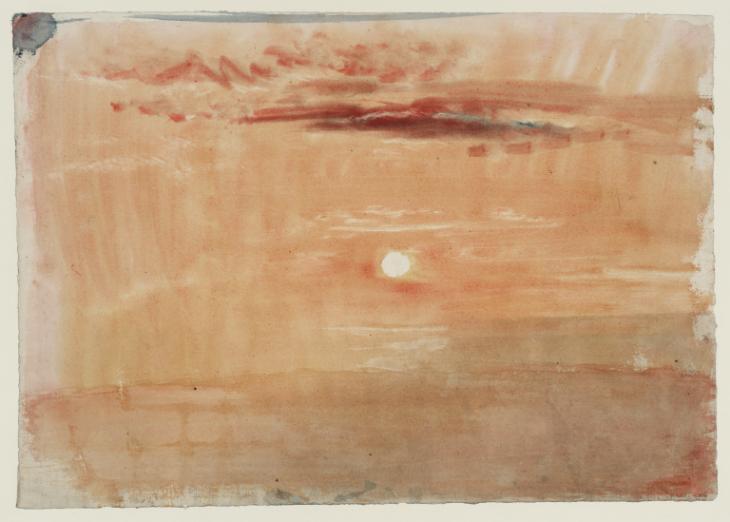Joseph Mallord William Turner The Sun Rising or Setting over Water c.1825-30
Joseph Mallord William Turner,
The Sun Rising or Setting over Water
c.1825-30
Joseph Mallord William Turner 1775–1851
The Sun Rising or Setting over Water c.1825–30
D25332
Turner Bequest CCLXIII 210
Turner Bequest CCLXIII 210
Watercolour on white wove paper, 245 x 346 mm
Blind-stamped with Turner Bequest monogram towards bottom right
Stamped in black ‘CCLXIII – 210’ bottom right
Blind-stamped with Turner Bequest monogram towards bottom right
Stamped in black ‘CCLXIII – 210’ bottom right
Accepted by the nation as part of the Turner Bequest 1856
Exhibition history
1975
Turner in the British Museum: Drawings and Watercolours, Department of Prints and Drawings, British Museum, London, May 1975–February 1976 (99, as ‘The sun setting over the sea in orange mist’, ?c.1825).
1978
¿¿¿¿¿¿ [Turner], Shipka Gallery, Sofia, Bulgaria, April[?–May] 1978, Belgrade, Serbia [former Yugoslavia], May, Muzeul de Arte al RS [Republica Socialista] Romania, Bucharest, June–July (26).
1979
J.M.W. Turner: Sea, Sky and Sun: Watercolours from the Turner Bequest, Loaned by the British Museum, Tate Gallery, London, December 1979–July 1980 (no catalogue).
1981
J.M.W. Turner (1775–1851) / ¿¿.¿.G. ¿e¿¿e¿ (1775–1851), National Pinakothiki, Athens, January–March 1981 (24, as ‘The sun setting over the sea in orange mist’, c.1825 reproduced in colour).
1991
Turner: The Fourth Decade: Watercolours 1820–1830, Tate Gallery, London, January–May 1991 (27, as ‘Sunset over water’, c.1825–7).
1993
The Great Age of British Watercolours, 1750–1880, Royal Academy of Arts, London, January–April 1993, National Gallery of Art, Washington, May-July (291, as ‘The Sun Setting over the Sea in Orange Mist’, c.1825, reproduced in colour).
1995
Making & Meaning: Turner: The Fighting Temeraire, National Gallery, London, July–October 1995 (71, as ‘The Sun Setting over the Sea in Orange Mist’, c.1825).
References
1820
A.J. Finberg, A Complete Inventory of the Drawings of the Turner Bequest, London 1909, vol.II, p.830, CCLXIII 210, as ‘Sunrise over the sea’, c.1820–30.
1975
Gerald Wilkinson, Turner’s Colour Sketches 1820–34, London 1975, p.140, reproduced in colour, as ‘“Sunrise”, or sunset’ among ‘Sunrise and sunset’ subjects.
1825
Andrew Wilton, Turner in the British Museum: Drawings and Watercolours, exhibition catalogue, Department of Prints and Drawings, British Museum, London 1975, p. 71 no.99, reproduced, as ‘The sun setting over the sea in orange mist’, ?c.1825.
1825
Lindsay Stainton in Dimitrios Papastamos, John Gage and Stainton, J.M.W. Turner (1775–1851) / ¿¿.¿.G. ¿e¿¿e¿ (1775–1851), exhibition catalogue, National Pinakothiki, Athens 1981, p.99 no.24, as ‘The sun setting over the sea in orange mist’, c.1825, reproduced in colour.
1825
Ian Warrell, Turner: The Fourth Decade: Watercolours 1820–1830, exhibition catalogue, Tate Gallery, London 1991, pp.11, 40 no.27, as ‘Sunset over water’, c.1825–7.
1997
Eric Shanes, Turner’s Watercolour Explorations 1810–1842, exhibition catalogue, Tate Gallery, London 1997, p.102, Appendix I, under ‘Sky Sketches’.
2012
Ian Warrell, ‘“The Land of Bliss”: Turner’s Pursuit of the Light and Landscapes of Claude’, in Warrell and others, Turner Inspired: In the Light of Claude, exhibition catalogue, National Gallery, London 2012, p.37, fig.21 (colour), as ‘Sunset over Water’, c.1825–7.
The central sun here, reserved as a blank disk of white paper, appears to be low over water, probably the sea with what may be a stretch of sandy beach in the foreground, all suffused with the ‘reddish colour of the sky’ while leaving ‘the source of the light pure’, as Ian Warrell has described it.1 Gerald Wilkinson has noted a ‘controlled brilliance achieved without primary colours’.2 Finberg thought it a sunrise,3 but it has also been exhibited and reproduced as a sunset.
Andrew Wilton has observed that the ‘rich colour and full-bodied paint suggest a date in the 1820s, rather than later’, comparing this study with Tate D25334 (Turner Bequest CCLXIII 212), associated with the ‘Little Liber’ series4 (see ‘Little Liber c.1823–6’ in the present catalogue); Lindsay Stainton has concurred, noting the 1823 watermark of a similar work,5 presumably Tate D25186 (Turner Bequest CCLXIII 64), a variation on the sun over water theme.
In regarding this sheet as dating from a little later in the 1820s, Ian Warrell has noted that such studies, with their ‘understanding gained through the kind of colour chiaroscuro’ seen here, informed the ‘richness’6 of the skies in paintings of the period such as Ulysses Deriding Polyphemus – Homer’s Odyssey, exhibited in 1829 (Turner Bequest, National Gallery, London),7 as well as informing the atmospheric effects of topographical watercolours in the Rivers of England and Picturesque Views in England and Wales series of the 1820s and 1830s.8
For other ‘colour beginnings’ focusing on a centrally placed sun, see the Introduction to this subsection.9
Verso:
Blank; inscribed by John Ruskin in pencil ‘AB 79 P | O’ top left, upside down; inscribed in pencil ‘CCLXIII | 210’ bottom right; inscribed in pencil ‘CCLXIII. 210’ top right, upside down.
The bottom edge appears dusty and darkened.
Matthew Imms
March 2016
How to cite
Matthew Imms, ‘The Sun Rising or Setting over Water c.1825–30 by Joseph Mallord William Turner’, catalogue entry, March 2016, in David Blayney Brown (ed.), J.M.W. Turner: Sketchbooks, Drawings and Watercolours, Tate Research Publication, November 2016, https://www

